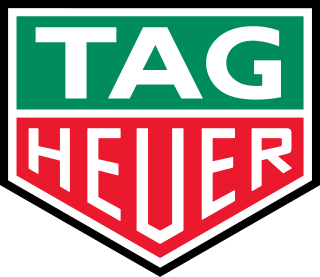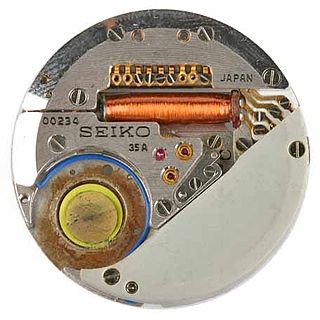
A watch is a portable timepiece intended to be carried or worn by a person. It is designed to keep a consistent movement despite the motions caused by the person's activities. A wristwatch is designed to be worn around the wrist, attached by a watch strap or other type of bracelet, including metal bands, leather straps, or any other kind of bracelet. A pocket watch is designed for a person to carry in a pocket, often attached to a chain.
Timex Group USA, Inc. is an American global watch manufacturing company founded in 1854 as the Waterbury Clock Company in Waterbury, Connecticut. In 1944, the company became insolvent but was reformed into Timex Corporation. In 2008, the company was acquired by Timex Group B.V. and was renamed Timex Group USA.

Seiko Group Corporation, commonly known as Seiko, is a Japanese maker of watches, clocks, electronic devices, semiconductors, jewelry, and optical products. Founded in 1881 by Kintarō Hattori in Tokyo, Seiko introduced the world's first commercial quartz wristwatch in 1969.

TAG Heuer S.A. is a Swiss luxury watchmaker. The company began as Uhrenmanufaktur Heuer AG, founded in 1860 by Edouard Heuer in St-Imier, Switzerland. In 1985, TAG Group purchased a majority stake in the company, forming TAG Heuer. In 1999, French luxury goods conglomerate LVMH bought nearly 100 percent of the Swiss company.The name TAG Heuer combines the initials of "Techniques d'Avant Garde" and the founder's surname.

A chronograph is a specific type of watch that is used as a stopwatch combined with a display watch. A basic chronograph has an independent sweep second hand and a minute sub-dial; it can be started, stopped, and returned to zero by successive pressure on the stem. More complex chronographs use additional complications and can have multiple sub-dials to measure seconds, minutes, hours and even fractions of a second. In addition, many modern chronographs use moveable bezels as tachymeters for rapid calculations of speed or distance. Louis Moinet invented the chronograph in 1816 for use in tracking astronomical objects. Chronographs were also used heavily in artillery fire in the mid to late 1800s. More modern uses of chronographs involve aircraft piloting, auto racing, diving and submarine maneuvering.
A. Lange & Söhne is a trademark of Lange Uhren GmbH, a German manufacturer of luxury and prestige watches. The company was originally founded by Ferdinand Adolph Lange in Glashütte, Kingdom of Saxony in 1845. The original A. Lange & Söhne was nationalized and ceased to exist in 1948, following the occupation by the Soviet Union after World War II. The current A. Lange & Söhne trademark was re-registered when Lange Uhren GmbH was founded in 1990 by Walter Lange, the great-grandson of Ferdinand Adolph Lange.

Swatch is a Swiss watchmaker founded in 1983 by Ernst Thomke, Elmar Mock, and Jacques Müller. It is a subsidiary of The Swatch Group. The Swatch product line was developed as a response to the "quartz crisis" of the 1970s and 1980s, in which inexpensive, battery-powered, quartz-regulated watches were competing against more established European watchmakers, focused on artisanal craftsmanship producing mostly mechanical watches.

Eco-Drive is a model range of watches manufactured and marketed worldwide by Citizen Watch Co., Ltd., powered primarily by light. As of 2007, the company estimated the drive system had eliminated the disposal of ten million batteries in North America.

Zenith SA is a Swiss luxury watchmaker. The company was started in 1865 by Georges Favre-Jacot in Le Locle in the canton of Neuchâtel and is one of the oldest continuously operating watchmakers. Favre-Jacot invented the concept of "in house movements", believing that only through control of the entire watchmaking process could the highest quality be achieved. Zenith was purchased by LVMH in November 1999, becoming one of several brands in its watch and jewelry division, which includes TAG Heuer and Hublot. Benoit de Clerck is president and CEO.

In horology, a complication is any feature of a timepiece beyond the display of hours, minutes and seconds. A timepiece indicating only hours, minutes and seconds is known as a simple movement. Common complications include date or day-of-the-week indicators, alarms, chronographs (stopwatches), and automatic winding mechanisms. Complications may be found in any clock, but they are most notable in mechanical watches where the small size makes them difficult to design and assemble. A typical date-display chronograph may have up to 250 parts, while a particularly complex watch may have a thousand or more parts. Watches with several complications are referred to as grandes complications.
Girard-Perregaux SA is a luxury Swiss watch manufacture with its origins dating back to 1791. In 2022, then-owner French luxury group Kering sold its stake in Sowind Group SA, the parent company of Girard-Perregaux, via management buyout. Headquartered in La Chaux-de-Fonds, Switzerland, the company opened the Girard-Perregaux Museum near its headquarters in Villa Marguerite in 1999. It is best known for the historic Tourbillon with three gold bridges, which was awarded a gold medal at the 1889 International Exposition in Paris soon after the launch of the watch. Other notable models from the company include the collection 1966, Vintage 1945, and models such as Tri-Axial Tourbillon and Laureato, an icon inspired from the 1970s.

Audemars Piguet Holding SA is a Swiss manufacturer of ultra luxury watches, headquartered in Le Brassus, Switzerland. The company was founded by Jules Louis Audemars and Edward Auguste Piguet in the Vallée de Joux in 1875, acquiring the name Audemars Piguet & Cie in 1881. The company has been family-owned since its founding.

Automatic quartz is a collective term describing watch movements that combine a self-winding rotor mechanism to generate electricity with a piezoelectric quartz crystal as its timing element. Such movements aim to provide the advantages of quartz without the inconvenience and environmental impact of batteries. Several manufacturers employ this technique.

Indiglo is a product feature on watches marketed by Timex, incorporating an electroluminescent panel as a backlight for even illumination of the watch dial.

The quartz crisis was the upheaval in the watchmaking industry caused by the advent of quartz watches in the 1970s and early 1980s, that largely replaced mechanical watches around the world. It caused a significant decline of the Swiss watchmaking industry, which chose to remain focused on traditional mechanical watches, while the majority of the world's watch production shifted to Japanese companies such as Seiko, Citizen, and Casio which embraced the new electronic technology.

Gallet (ˈgæl.eɪ) is a historic Swiss manufacturer of high-end timepieces for professional, military, sports, racing, and aviation use. Gallet is the world's oldest clock making house with history dating back to Humbertus Gallet, a clock maker who became a citizen of Geneva in 1466. The Gallet & Cie name was officially registered by Julien Gallet (1806–1849) in 1826, who moved the family business from Geneva to La Chaux-de-Fonds, Switzerland. Prior to this date, operations commenced under the name of each of the Gallet family patriarchs.

The TAG Heuer Monaco is a series of automatic chronograph wristwatches originally introduced by Heuer in 1969 in honour of the Monaco Grand Prix. The Monaco was revolutionary for being the first automatic square cased chronograph. The Hollywood film star Steve McQueen used the watch to accessorize his character in the 1971 film Le Mans. In the decades after his death the use of film stills has made the watch synonymous with McQueen. Although it was discontinued in the mid-1970s, the Monaco was reissued with a new design in 1998 and was reintroduced again with an entirely new mechanisms in 2003 in response to McQueen's increasing popularity.

Christian Jacques is a Swiss brand of watches based in Basel (Switzerland). Christian Jacques is also one of the last independent brands in the Swiss watch industry.

Montres Tudor SA, or simply Tudor, is a Swiss watchmaker based in Geneva, Switzerland. Registered in 1926 by Hans Wilsdorf, founder of Rolex, the brand remains a sister company to Rolex; both companies are owned by the Hans Wilsdorf Foundation. Tudor was initially known for watches produced for the military and professional divers. From the 1960s to 1980s, several navies issued Tudor Submariners to their divers, including the US Navy SEALs and the French Marine Nationale.
















